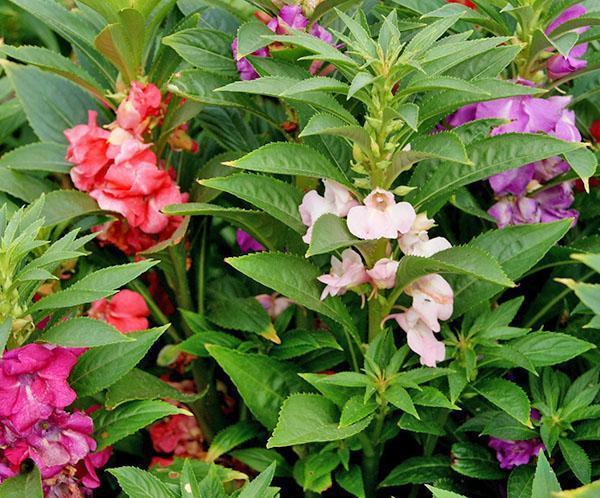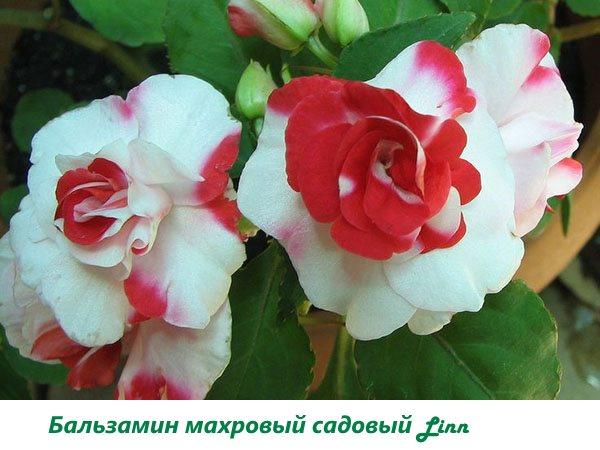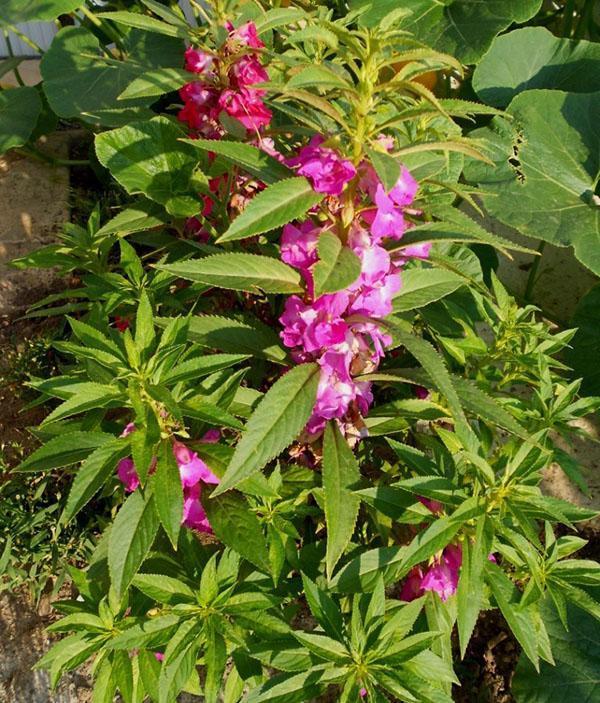Descriptions and photos of popular varieties of balsam and its types
 Balsams or touch-me-nots is a vast family of plants native to Asia and Africa, but native to virtually every corner of the world. In a genus of several hundred species, there are annual and perennial, two-meter and very small plants.
Balsams or touch-me-nots is a vast family of plants native to Asia and Africa, but native to virtually every corner of the world. In a genus of several hundred species, there are annual and perennial, two-meter and very small plants.
With all the differences in appearance and habitat, balsams, as in the photo, bloom magnificently, therefore, they are grown as ornamental plants both in gardens and on home windowsills.
True, among the cultivated species in Russia, only a few have been able to become truly popular so far. it garden balsam, Waller's balsam, suitable for indoor and garden cultivation, as well as New Guinea balsams gaining more and more fans with unusually large flowers of bright colors.
Garden balsam (Impatiens balsamina)

Travelers who visited mysterious China, India and other countries of the region remote from Europe could not pass by specimens with white, pink, red or purple flowers. Therefore, soon garden, especially terry balsamines appeared in flower beds and greenhouses in France, Italy, Holland and Great Britain.
The annual culture is easy to recognize:
- on strong, juicy stems with pronounced knots;
- on lanceolate petiolate leaves with serrated edges, densely covering the shoots;
- irregular decorative flowers located in the leaf axils.
 The stems of garden balsam, as in the photo, branch, which allows you to get a dense crown, strewn with flowers of all kinds of colors and shades from June to September.
The stems of garden balsam, as in the photo, branch, which allows you to get a dense crown, strewn with flowers of all kinds of colors and shades from June to September.
After flowering is complete, succulent pods with brown, rounded seeds appear on the plants. Like many other varieties of balsams in the touch-sensitive garden, the contents of the box instantly scatter several meters around, as soon as you touch the fruit, or the plants touch from a gust of wind.
 In the subtropics, in the homeland of culture, this feature helps balsams to quickly settle. But in the middle lane, thermophilic plants do not tolerate cold weather, therefore balsams of this type are planted in the garden only after the end of the frost period. Garden touchiness will also decorate the room, but additional humidification of the air will probably be required here.
In the subtropics, in the homeland of culture, this feature helps balsams to quickly settle. But in the middle lane, thermophilic plants do not tolerate cold weather, therefore balsams of this type are planted in the garden only after the end of the frost period. Garden touchiness will also decorate the room, but additional humidification of the air will probably be required here.
Garden balsam varieties are not so numerous, and most of them are of European origin and were obtained for a long time. Breeders have bred plants with flowers of various colors, in shape and structure resembling garden roses, camellias and carnations.
 When choosing a variety for planting on a curb or flower bed, it should be borne in mind that garden plants can have a height of up to 70 different heights. For example, plants from the Camellia Flowered group are quite tall, and most of the flowers are concentrated in the upper part of the shoots.
When choosing a variety for planting on a curb or flower bed, it should be borne in mind that garden plants can have a height of up to 70 different heights. For example, plants from the Camellia Flowered group are quite tall, and most of the flowers are concentrated in the upper part of the shoots.
To obtain an original color spot or edging, it is better to choose dwarf subspecies. An example is the popular Tom Thumb balsam shown in the photo.
Tom Tamb balsam plants do not exceed 25 cm, they are rich in colors and long flowering.Terry flowers, replacing each other, open from June to mid-autumn, as long as the air temperature allows.
Waller's balsam (Impatiens walleriana)
Waller's balsam, the most common on Russian windows, and also used for seasonal outdoor gardening, has many names. Since its discovery in the middle of the 19th century, the plant has been called Impatiens sultanii in honor of the ruler of Zanzibar, the birthplace of this decorative culture.
 For many years, Russian flower growers have been well acquainted with this species under the slightly familiar nickname of the balsam Vanka Wet or under the popular name "light" for the brightness of the flowers flaming on the bush. Because of the love of water and its multicolor nature, balsam is also called “water fuchsia”.
For many years, Russian flower growers have been well acquainted with this species under the slightly familiar nickname of the balsam Vanka Wet or under the popular name "light" for the brightness of the flowers flaming on the bush. Because of the love of water and its multicolor nature, balsam is also called “water fuchsia”.
Unlike its garden counterpart, Waller's balsam is a perennial plant of a very small size. Under indoor conditions, the culture gives a compact branching bush up to 30-40 cm high. Under indoor conditions, the plants are higher than in the garden, and with regular pinching they bush well and do not lose their decorative effect for several years.
 In the garden, Waller's balsams are somewhat lower; they can grow and bloom only in the summer months in the absence of harmful frosts. The culture is planted in the soil with seedlings, and flowering begins 50–70 days after transplanting to a permanent place.
In the garden, Waller's balsams are somewhat lower; they can grow and bloom only in the summer months in the absence of harmful frosts. The culture is planted in the soil with seedlings, and flowering begins 50–70 days after transplanting to a permanent place.
This species is distinguished by single flowers with a flattened shape and a lot of colors. Plants prefer places that are closed from drafts in partial shade. The sun makes the color of the flowers dimmer, and the wind can easily break the shoots that are fragile at the nodes.
Once in the hands of breeders, the culture has produced many spectacular, like a photo, popular varieties of balsam. The gamut and variety of bred flowers are simply amazing, but with all the diligence, botanists cannot get plants with flowers of yellow and blue hues. Varieties and hybrids of Waller's balsam are combined into groups of similar corollas in shape, flowering times and other external signs of plants. This is for ease of classification and convenience for gardeners.
 For example, the vast group of hybrid Impreza balsams are plants 15–20 cm high, with strong stems, short internodes and an excellent ability to form lateral shoots. The series includes plants with raspberry, purple and carmine, simple flowers. And also specimens with original white or slightly pink corollas, decorated with a bright red spot in the center.
For example, the vast group of hybrid Impreza balsams are plants 15–20 cm high, with strong stems, short internodes and an excellent ability to form lateral shoots. The series includes plants with raspberry, purple and carmine, simple flowers. And also specimens with original white or slightly pink corollas, decorated with a bright red spot in the center.
 Today the most popular varieties of balsamines with lush double flowers. Large corollas make the plant more decorative and attractive.
Today the most popular varieties of balsamines with lush double flowers. Large corollas make the plant more decorative and attractive.
In addition to varieties with erect shoots, flower growers are offered touch-me-not ampelous balsams, which grow well in hanging baskets and pots, suitable for decorating not only interiors, but also open terraces in a country house.
In the open air, Waller's balsams bloom during the summer season, indoors the formation of buds is ongoing, but only when maintaining a relatively low temperature in the range of 16-19 ° С.
Hocker's balsam (Impatiens hawkeri)
 This type of balsam in the wild grows in New Guinea and the Solomon Islands. In appearance, it is very similar to Waller's balsam, but in this case the flowers are larger, their color is richer, and the plants themselves are more hardy.
This type of balsam in the wild grows in New Guinea and the Solomon Islands. In appearance, it is very similar to Waller's balsam, but in this case the flowers are larger, their color is richer, and the plants themselves are more hardy.
The wild varieties discovered in 1884 were not widely used as ornamental plants in Europe or other countries, but became the basis for large-scale breeding work.
Balsam New Guinea (Impatiens Neuguinea)
 In 1972, a group of hybrid balsams was introduced to the world of flower growers, named after the homeland of their wild-growing ancestors. New Guinea balsams were bred by interspecific crossing, one hundred allowed to achieve:
In 1972, a group of hybrid balsams was introduced to the world of flower growers, named after the homeland of their wild-growing ancestors. New Guinea balsams were bred by interspecific crossing, one hundred allowed to achieve:
- high plant resistance to drought;
- larger flowers;
- expanding the range of colors;
- obtaining variegated varieties.
 Like Waller's balsam, the new hybrid plants in the room are decorative perennials. They are distinguished by a dense, well-branching crown, large, up to 6 cm in diameter, continuously forming flowers and unpretentious care. In the open field, the culture does not tolerate winter, therefore it is grown as an annual.
Like Waller's balsam, the new hybrid plants in the room are decorative perennials. They are distinguished by a dense, well-branching crown, large, up to 6 cm in diameter, continuously forming flowers and unpretentious care. In the open field, the culture does not tolerate winter, therefore it is grown as an annual.
New Guinea balsams are leaders among related species in terms of corolla size, but form predominantly simple or semi-double flowers. Terry balsams in this case are rare.